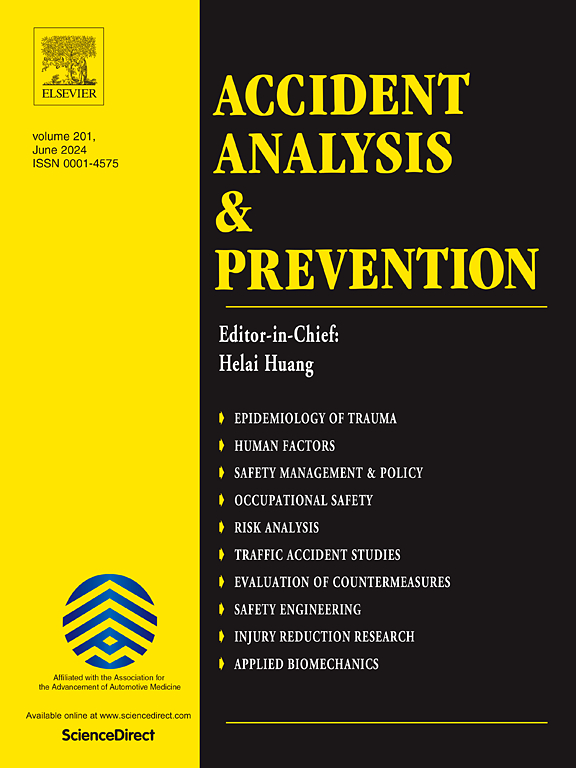Can mid-block pedestrian signals (MPS) provide greater safety benefits than other mid-block pedestrian crossings?
IF 5.7
1区 工程技术
Q1 ERGONOMICS
引用次数: 0
Abstract
The Florida Department of Transportation (FDOT) has recently implemented a new midblock signal system known as the Midblock Pedestrian Signal (MPS) to enhance pedestrian safety. This study evaluates the effectiveness of MPSs by comparing their safety performance with other existing midblock crossing treatments. Portable CCTV video data were collected from 14 MPS equipped locations, in addition to five reference sites, to calculate Conflict Modification Factors (CoMFs) using vehicle–pedestrian conflict data. Advanced computer vision techniques, specifically the RT-DETR model for object detection and the ByteTrack algorithm for tracking were utilized to process the video data. The study employed both Cross-Sectional (CS) and Before-After methods, incorporating the Comparison Group (CG) and Empirical Bayesian (EB) approaches to evaluate the safety impacts of MPSs. To address repeated observations at the same locations and minimize bias, Safety Performance Functions (SPFs) were developed using Generalized Estimating Equations (GEE) with a Negative Binomial distribution, which proved more robust than traditional Generalized Linear Models (GLMs). The results demonstrate that MPS systems outperform Rectangular Rapid Flashing Beacons (RRFBs) and Flashing Beacons in reducing pedestrian-vehicle conflicts. Furthermore, when compared to Pedestrian Hybrid Beacons (PHBs) which share similar functionalities but differ in signal phase management—MPS systems provided additional safety benefits. Compared to PHBs, MPS systems reduced serious and all conflicts by between 26–33% and 31–33%, respectively, using the EB, CG and the CS methods. These reductions highlight the superior safety performance of MPS systems compared to PHBs and other midblock crossing treatments. With their adaptability, cost-effectiveness, and enhanced safety benefits, MPS systems are a promising alternative for upgrading existing pedestrian crossings or installing new signal systems to improve pedestrian safety at midblock locations.
街区中间行人信号系统是否比其他街区中间行人过路系统更安全?
佛罗里达州交通部(FDOT)最近实施了一个新的街区中间信号系统,称为街区中间行人信号(MPS),以提高行人安全。本研究通过将mps的安全性能与其他现有的中间块交叉治疗进行比较来评估mps的有效性。从14个安装了MPS的地点以及5个参考地点收集便携式CCTV视频数据,利用车辆-行人冲突数据计算冲突修正因子(CoMFs)。利用先进的计算机视觉技术,特别是用于目标检测的RT-DETR模型和用于跟踪的ByteTrack算法来处理视频数据。本研究采用横截面法(CS)和前后法(Before-After),结合对照组法(CG)和经验贝叶斯法(EB)来评估mps的安全性影响。为了解决在同一位置的重复观测并最大限度地减少偏差,使用负二项分布的广义估计方程(GEE)开发了安全性能函数(spf),该模型比传统的广义线性模型(GLMs)更具鲁棒性。结果表明,MPS系统在减少行人与车辆冲突方面优于矩形快速闪烁信标(rrfb)和闪烁信标。此外,与行人混合信标(phb)相比,mps系统具有相似的功能,但在信号相位管理方面有所不同,mps系统具有额外的安全优势。与PHBs相比,使用EB、CG和CS方法,MPS系统分别减少了26-33%和31-33%的严重冲突和全部冲突。与PHBs和其他中间区块交叉处理相比,MPS系统的安全性更高。MPS系统具有适应性、成本效益和增强的安全效益,是一种有希望的替代方案,可用于升级现有的人行横道或安装新的信号系统,以改善街区中部的行人安全。
本文章由计算机程序翻译,如有差异,请以英文原文为准。
求助全文
约1分钟内获得全文
求助全文
来源期刊

Accident; analysis and prevention
Multiple-
CiteScore
11.90
自引率
16.90%
发文量
264
审稿时长
48 days
期刊介绍:
Accident Analysis & Prevention provides wide coverage of the general areas relating to accidental injury and damage, including the pre-injury and immediate post-injury phases. Published papers deal with medical, legal, economic, educational, behavioral, theoretical or empirical aspects of transportation accidents, as well as with accidents at other sites. Selected topics within the scope of the Journal may include: studies of human, environmental and vehicular factors influencing the occurrence, type and severity of accidents and injury; the design, implementation and evaluation of countermeasures; biomechanics of impact and human tolerance limits to injury; modelling and statistical analysis of accident data; policy, planning and decision-making in safety.
 求助内容:
求助内容: 应助结果提醒方式:
应助结果提醒方式:


